This week I examine another very important aspect of the stamps issued as part of this series: the tagging. This is the first series for which all the major values, except for the $2 are found with some form of tagging. Like the previous Centennial issue, some values can be found with both Ottawa and Winnipeg tagging, but by and large, Ottawa tagging was the standard form of tagging used. Also, the first printings of the middle values to be Ottawa Tagged used the unstable OP-4 tagging compound, which migrated through the stamps. This was later changed to a more stable OP-2 compound. The Ottawa tagging was originally done by way of 3 mm bars, but these were later widened to 4 mm.
This is as far as all the standard catalogues go on this topic, and I might add that this is a much greater level of detail than the used to cover. When I was a young boy, the catalogues only distinguished between Winnipeg and Ottawa tagging and that was it. There were no listings for OP-4 versus OP-2 and no differentiation between 3 mm tagging bars and 4 mm ones.
It may surprise collectors to learn that there are actually two additional dimensions to study when looking at the tagging of this issue, as well as the various errors and shifts that are encountered as well. I will cover these two aspects in detail in the remainder of this post:
- The intensity of the tagging compound on the stamp, as it appears under normal lighting conditions.
- The method by which the tagging was applied, as shown by its appearance.
As we shall see the low values printed by the CBN show a considerable variation in how the tagging appears under normal light. On some stamps the tagging is so light that the stamps almost appear to be untagged. Most stamps have tagging that is a light yellowish cream - visible, but not dark. Still, there are other printings, usually later ones where the tagging is a very dark yellow. It is not clear whether or not these differences result from the application of different amounts of taggant, or whether they result from chemical variations in the taggant compound itself. However, they are very distinct, and I believe, collectible.
If you study the commemorative stamps of the period and then the stamps of this series you will also notice a difference in the way the tagging appears to have been applied to the stamps that were printed by BABN. For CBN, there is no difference - all the tagging appears smooth and solid - being very likely applied by flexography, which is the modern equivalent of typography. However, the BABN appears to have initially applied the tagging using screened photogravure, as clear screening dots can be seen in the tagging when it is examined under ultraviolet light. This did not appear to be satisfactory as it often resulted in weak and incomplete tagging bars. This can be seen on the 1973 Commonwealth Heads of Government stamps, where narrow appearing, weak and partially incomplete tagging is commonly seen.
It would appear that after re-designing their printing process, the BABN began using rubber cylinders to apply the tagging. I suspect that rubber was used as the tagging appears mottled and solid when viewed under ultraviolet light. This appearance is approximately the same as what we would expect to see if we applied paint to a wall using a rubber roller. This is generally how the BABN printed commemoratives and stamps of this series appear after 1974. Similar differences can be seen in the tagged stamps of other countries during this period. For example many of the stamps of Great Britain issued during this period show similar differences in the appearance of the tagging on stamps. So, to me, this supports the notion that this is a significant and collectible difference, when considering the tagging.
The remainder of this post will look at the basic differences between the tagging used by the CBN and BABN and will incorporate a discussion of these two aspects.
The Tagging Used by the CBN
The CBN used only OP-2 taggant on the low value stamps that it printed. In all cases, the tagging appears completely solid, both under normal light, and under UV light. The tagging was applied in bars that are 4 mm wide, down the vertical perforations on the sheets. The spacing between the bars is 16 mm.
Stamps printed by CBN can be found with either light tagging, moderate tagging and dark tagging. The scan below shows the different appearance of these types under normal light:
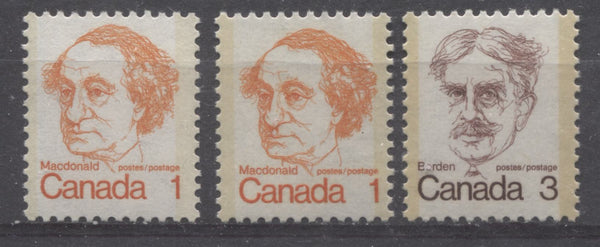
The dark tagging is shown on the right had 3c stamp, while the moderate tagging is shown in the middle stamp. The left stamp shows the light tagging. As you can see the differences between these stamps are quite noticable.
Here are the same stamps as seen under UV light:

As you can see, the tagging on all three stamps appears completely solid. However, the colour of the tagging does show a very subtle difference. The tagging of the lightly tagged stamps appears a distinct greenish yellow, whereas the darker tagging appears a pure, deep, bright, yellow that does not have the greenish tinge.
The darker tagging appears to correspond to the latest printings of these stamps, made between 1976 and 1978. I would suspect that the light tagging corresponds to the earlier 1973 and 1974 printings.
The coil stamps exhibit the lightest tagging of all. I have seen the moderate and light tagging, as well as an even lighter tagging that, for all intents and purposes, appears invisible in normal light. The scan below shows all three types:
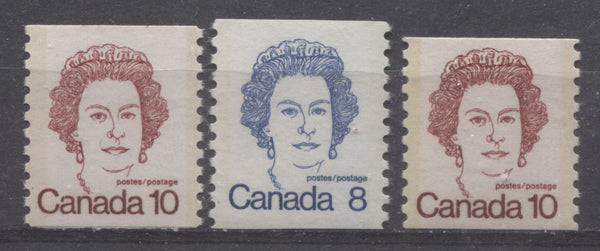
The "invisible" tagging is shown on the 8c stamp in the centre, while the light tagging is shown on the left stamp, and the moderate tagging is shown on the right stamp. I have found that the tagging on these stamps tends to appear slightly greenish yellow, and have not seen any that are the really deep, bright yellow that the stamps with dark tagging are.
I have not seen any variation in the width of the tagging bars, nor have I seen any variation in the spacing between tagging bars. However, there are several instances on most values in which the tagging bars are shifted, resulting in 1 4 mm bar down the stamp. In some cases the bar appears more or less down the centre, on on other stamps, the bars appear at the extreme right, or left hand side of the stamp:
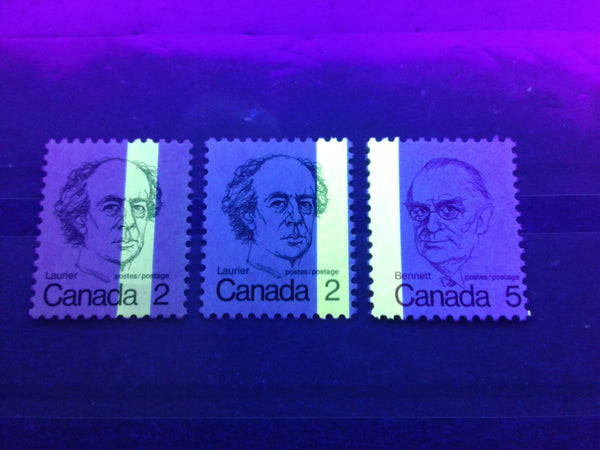
The stamp on the left shows a centre tag bar, and appears greenish yellow under the UV light, suggesting that it is from one of the earlier printings. The centre stamp shows a right hand band, while the right stamp shows a left hand band. These two examples both show the much brighter yellow that completely lacks any greenish undertone under UV light.
The BABN Tagging Used on The Sheet Stamps and Booklets
On the low value sheet and booklet stamps that the BABN printed, the same tagging configuration of 4 mm wide bands, spaced 16 mm apart was used. Generally, the tagging appeared much lighter than on the CBN stamps, with almost all stamps being of either the "invisible" or light variety. On many printings of the 8c Queen stamps, the blue ink has mixed in with the taggant compound, resulting in tagging that appears very light blue in colour.
The scan below shows three examples of BABN sheet and booklet stamps as seen under normal light:
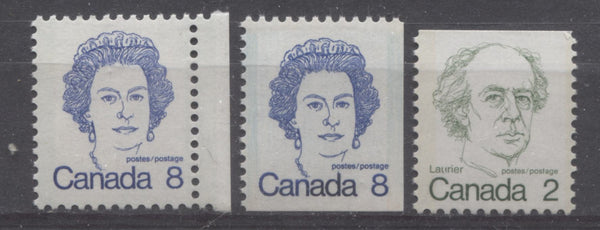
The stamps at the sides have the "invisible" tagging, while the middle stamp has the light blue tagging described above. Generally this tagging can be seen if the stamps are held at an angle to a strong light source, as a slight sheen running down the stamps.
The picture below shows the appearance of these stamps under UV light:
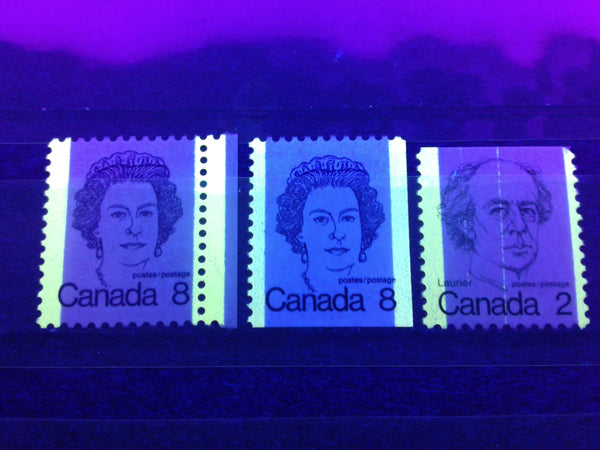
It is difficult to see in this picture, but if you look at the bottom half of the right tagging bar of the middle stamp and the bottom of the left tagging bar of the right stamp, you can see the mottling of the tagging. The tagging generally appears greenish yellow under UV. The right stamp shows a hairline of tagging down the centre and left of the stamp. These varieties commonly occur on the booklet stamps printed by BABN.
Like the CBN printed stamps, the BABN stamps can be found with similar shifts in the tagging.
Tagging Found on the 10c-50c Values
The initial printings of these stamps had Winnipeg tagging that was applied down the vertical perforations in 8 mm bands that were spaced 15.75 mm apart. These bands appear light cream under normal light and bluish white under UV light. The tagging does exhibit a 1-2 second afterglow when the UV light source is suddenly switched off. The tagging bars themselves always appear dotted, as though applied using photogravure. After this was phased out, the next printings used OP-4 3 mm Ottawa tagging. This tagging appears a very similar colour under UV to the Winnipeg tagging, with some examples appearing more yellowish than bluish. The tagging bars were 3 mm wide, and were spaced 21 mm apart. Unlike the Winnipeg tagging, which appears as slightly darker bands along the sides of the tagged stamps, the OP-4 tagging bars are invisible under normal light.
The picture below shows examples of the Winnipeg tagging and OP-4 Ottawa tagging:
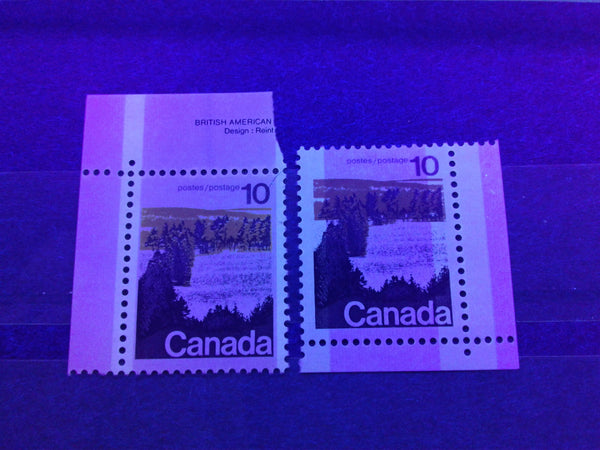
The OP-4 tagging is shown at the left, while the Winnipeg tagging is shown on the right stamp.
The OP-4 taggant was phased out by late 1972 and replaced by the more stable OP-2 taggant. Initially, the tagging was applied in 3 mm wide bands, spaced 21 mm apart, and later the bands were widened to 4 mm bands, spaced 20 mm apart. I have read in one of the philatelic publications a few years ago, I cannot recall where now, that some examples of the 10c have been discovered with 2 mm tagging bars. I have not seen these, so I cannot confirm their existence. The tagging generally appears mottled and applied with rubber cylinders.
The picture below shows both types of OP-2 tagging below:
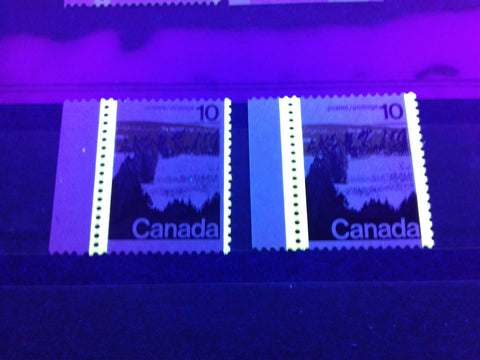
The 3 mm tagging is shown on the left, while the 4 mm tagging is shown on the right. Generally the visibility in normal light of the 3 mm tagging varies from invisible, to just barely visible, as slightly shiny bands running down the sides of the stamps. The 4 mm tagging on the other hand is usually very clearly visible as glossy bands running down the sides of the tagged stamps.
I have not yet come across any significant tagging shifts on these, although Rose lists several varieties that can be found on all five of the medium values. I have come across an interesting tagging variety on the OP-4 printing of the 15c Mountain sheep, in which a spot of taggant has gotten on the mountain, resembling a "low moon", as shown below:
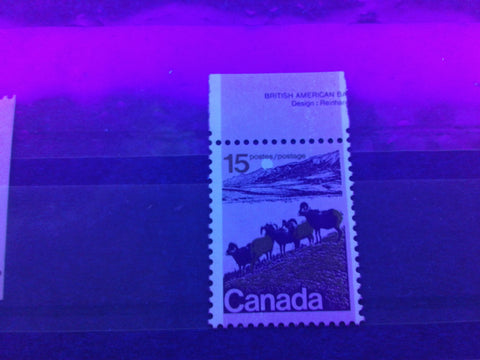
The Tagging Found on the BABN Printing of the $1 Vancouver
The printings of this stamp from 1973 to 1978 utilize the same tagging as the mid-values, with the only major difference being the spacing between the tagging bars, with those stamps having 3 mm bars being 44 mm apart and those having 4 mm bands being just 43.5 mm apart. This value however shows the full transition in the method of application used for the tagging, from photogravre to rubber cylinders. The first printings show tagging that has a clear "screened" appearance, while later printings show tagging that appears much more solid, only showing slight dotting. The later printings show tagging that has a full mottled appearance. In normal light, the tagging that is not mottled, is not clearly visible on the stamps. In contrast, the mottled tagging can always be seen as shiny narrow bands at the sides of the stamp.
The picture below shows all three of these tagging types:
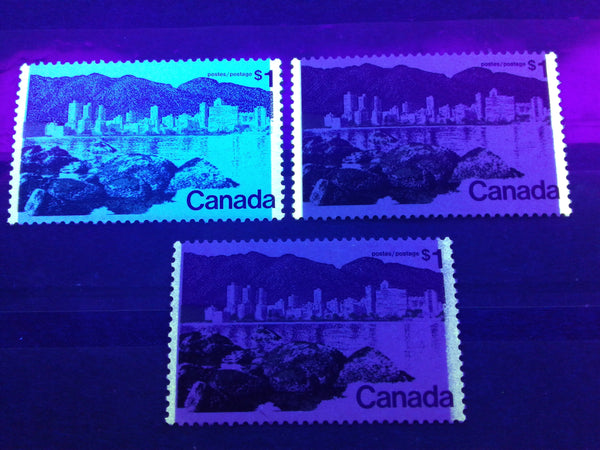
The initial printing from 1973 is shown by the bottom stamp. Here, you can see that the tagging looks weak and incomplete compared to the other stamps above it. In actual fact, the tagging appears to have been applied by screened photogravure, which did not work well with the chalk coating. A later printing is shown by the top right stamp, which shows tagging that appears much more solid. The top left stamp is one of the later perf. 12.5 x 12 printings on hibrite paper that shows tagging that appears mottled, much like the tagging found on the perf. 13.3 printings.
This concludes my examination of the tagging. This leaves us with just the gum and the paper as the remaining characteristics remaining to study on these stamps. Next week I will look at the gum and the chalk surfacing found on the different printings of the stamps. Then, I will be ready to start discussing the papers used in depth.

